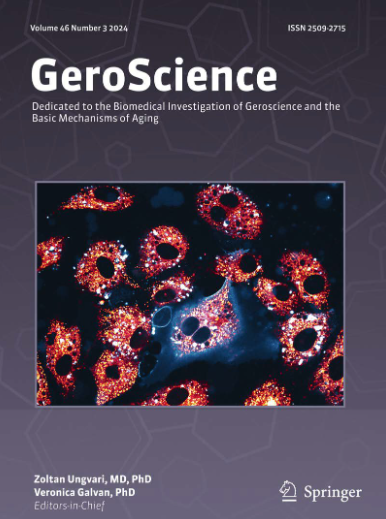社区居住中年男性主观记忆顾虑、消极情绪与皮层微观结构完整性。
IF 5.4
2区 医学
Q1 GERIATRICS & GERONTOLOGY
引用次数: 0
摘要
对记忆力的担忧往往随着年龄的增长而增加,并被认为是即将发生的记忆障碍或痴呆的前兆。然而,主观记忆担忧(SMC)也被证明反映了一个人对记忆的担忧倾向,这种倾向与消极情绪的联系比与客观记忆表现的联系更紧密。尽管行为学证据支持SMC的特征维度,但其神经解剖学基础仍未得到充分探索。在477名社区居住的无痴呆男性(56-72岁)中,我们研究了SMC和皮层平均扩散率(cMD)之间的关系,cMD是一种基于弥散性mri的灰质微结构完整性度量,生成了它们之间的全脑关联图。收集自我报告的特质焦虑和抑郁症状,以及基于三个神经心理学任务的客观记忆评分,这些任务还生成了它们与cMD关联的脑图。最后,我们进行了空间相关分析来比较这些脑关联图的空间模式,以评估它们之间是否存在显著的空间相似性。我们发现SMC的灰质完整性在空间上与抑郁症状和特质焦虑相似,但与客观记忆不同。负性情绪测量的灰质完整性与脑内皮层的空间对应关系显著强于脑内皮层与客观记忆的空间对应关系。总之,这些结果表明了特征样SMC的神经解剖学基础,它应该与状态相关的SMC区分开来,后者可能是研究和临床环境中客观记忆缺陷的前兆。本文章由计算机程序翻译,如有差异,请以英文原文为准。
Subjective memory concern, negative affect, and cortical microstructural integrity in community-dwelling middle-aged men.
Concerns about memory often increase with age and have been suggested as a precursor to impending memory impairment or dementia. However, subjective memory concern (SMC) has also been shown to reflect an individual's trait-like tendency to worry about memory, which is more strongly linked to negative affect than to objective memory performance. Despite behavioral evidence supporting a trait-like dimension of SMC, its neuroanatomical underpinnings remain underexplored. In 477 community-dwelling dementia-free men (56-72 years old), we investigated the association between SMC and cortical mean diffusivity (cMD)-a diffusion MRI-based metric of gray matter microstructural integrity-generating a brain-wide map of their association. Self-report trait anxiety and depressive symptoms were collected, along with objective memory scores based on three neuropsychological tasks for which brain maps of their association with cMD were also generated. Finally, we conducted spatial correlational analyses to compare the spatial patterns of these brain association maps to assess whether there were significant spatial resemblances between each. We found that the gray matter integrity correlates of SMC spatially resembled those of depressive symptoms and trait anxiety but not those of objective memory. The spatial correspondences between gray matter integrity correlates of negative affect measures and SMC were significantly stronger than those between SMC and objective memory. Together, these results suggest a neuroanatomical basis of trait-like SMC, which should be distinguished from state-related SMC that may be a precursor of objective memory deficits in research and clinical settings.
求助全文
通过发布文献求助,成功后即可免费获取论文全文。
去求助
来源期刊

GeroScience
Medicine-Complementary and Alternative Medicine
CiteScore
10.50
自引率
5.40%
发文量
182
期刊介绍:
GeroScience is a bi-monthly, international, peer-reviewed journal that publishes articles related to research in the biology of aging and research on biomedical applications that impact aging. The scope of articles to be considered include evolutionary biology, biophysics, genetics, genomics, proteomics, molecular biology, cell biology, biochemistry, endocrinology, immunology, physiology, pharmacology, neuroscience, and psychology.
 求助内容:
求助内容: 应助结果提醒方式:
应助结果提醒方式:


